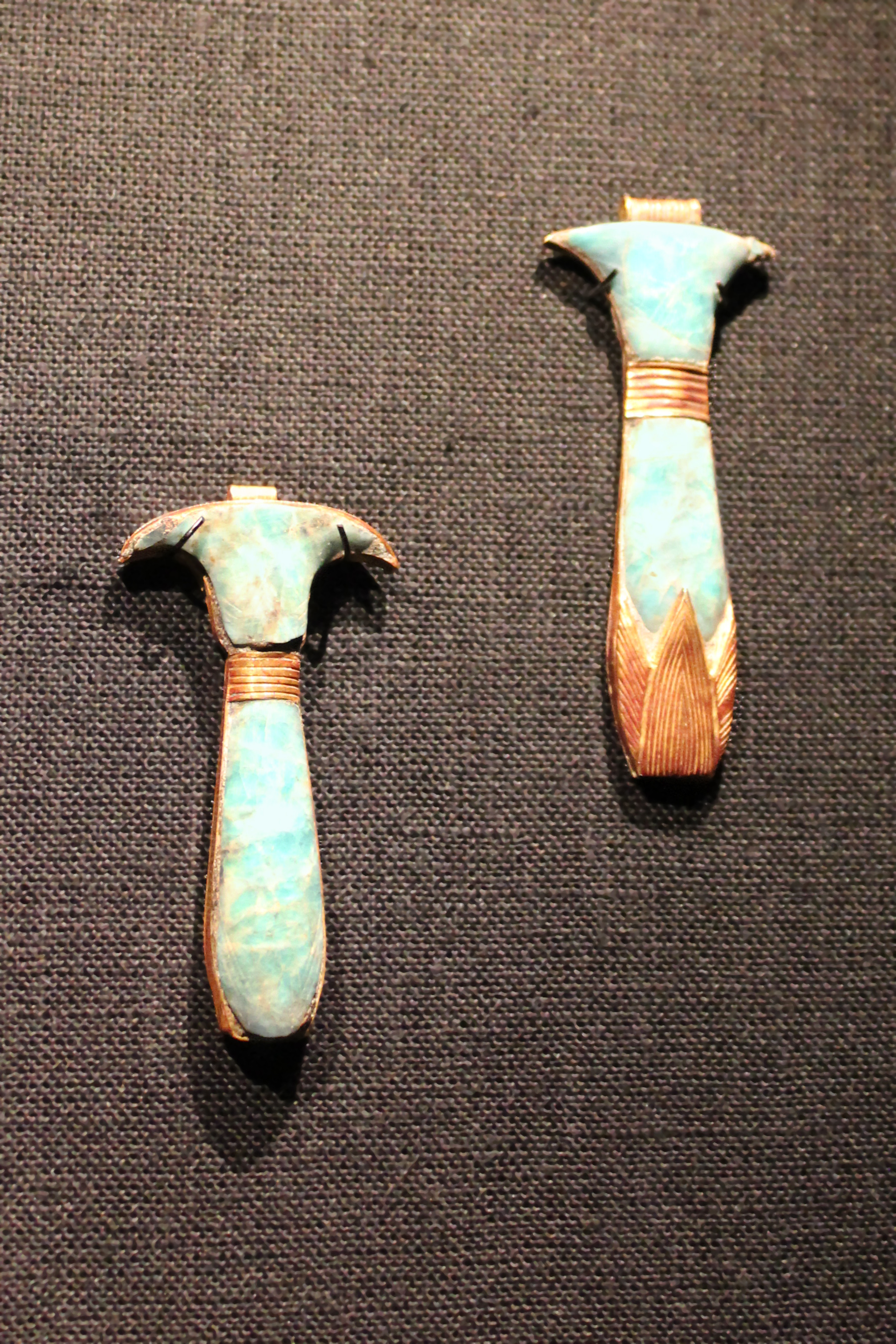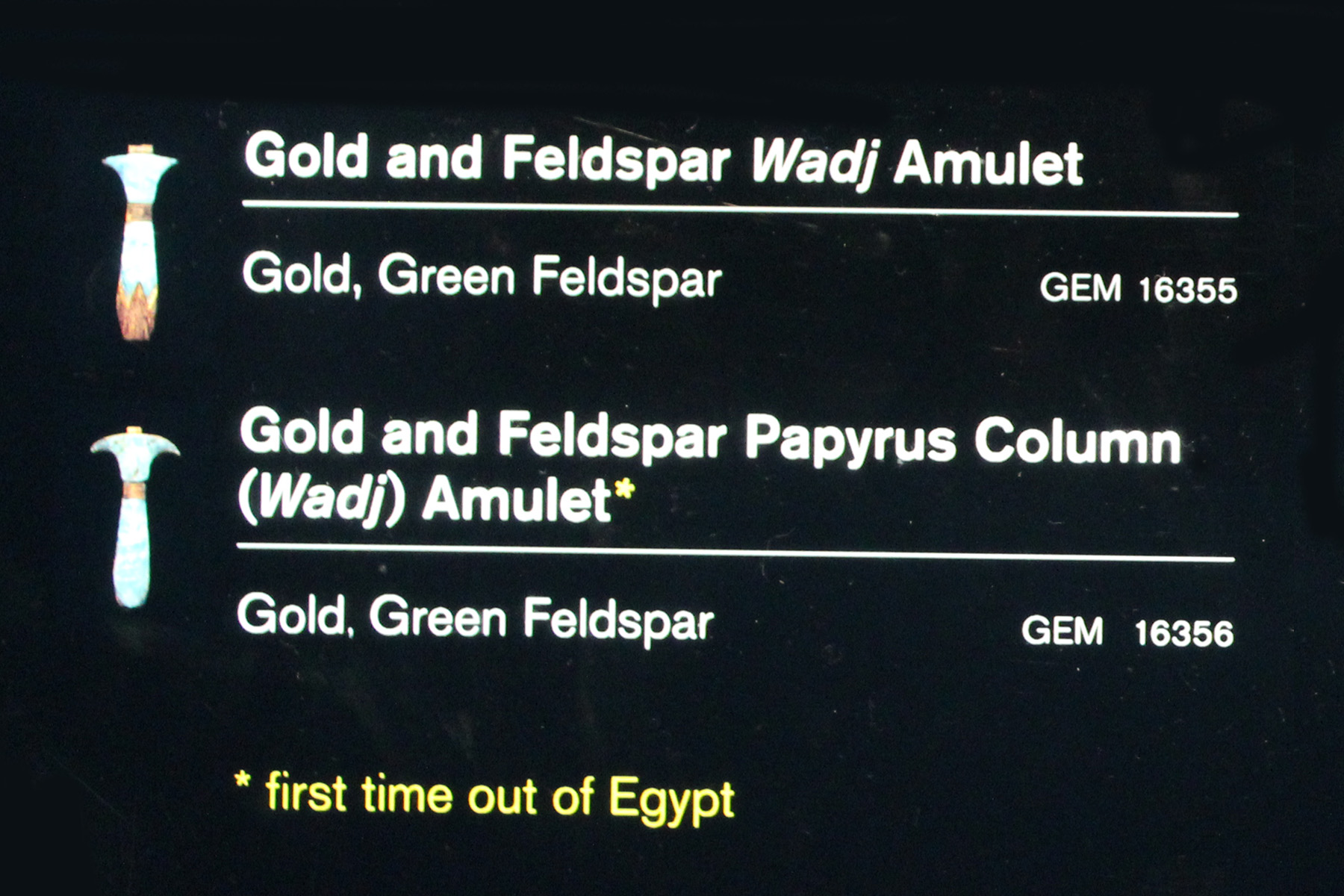
LEFT: Gold and Feldspar Papyrus Column (Wadj) Amulet, GEM #16356
RIGHT: Gold and Feldspar Wadj Amulet, GEM #16355

 LEFT: Gold and Feldspar Papyrus Column (Wadj) Amulet, GEM #16356 RIGHT: Gold and Feldspar Wadj Amulet, GEM #16355 
|
|
"Spell 160 of the Book of the Dead concerns 'the giving of a papyrus column of green Feldspar which is not flawed, which the hand of Thoth supports, for he abhors imperfection. If it is intact, then I shall be healthy, if it is undamaged, then I shall be undamaged; if it is not hit, then I shall not be hit. It is what Thoth has said that joins your spine together." (T.G.H. James, Tutankhamun, Metro books/White Star 2000) page 166) "A gold papyrus column inlaid with feldspar was found between two djed columns on Tutankhamun's neck."(T.G.H. James, page 166) But here we have two examples, perhaps both were found on his neck? There were two djed pillars, at least one of them gold, found at Tutankhamun's neck (T.G.H. James, page 165) James' book has a photo of a gold djed pillar that was found there. Why are the papyrus column amulets used, what do they represent? They are stylized depictions of the papyrus plant, upon which so much of Egyptian life was dependant.
"The plant was very important in everyday life; it was put to numerous
practical uses from sandal-making and basketry to the construction of river
craft, as the Greek writer Herodotus noted in the fifth century BC. He
mentioned the making of sails and papyrus rope (which was widely used in the
Mediterranean and features in Homer's Odyssey) and he recorded that the
lower part could be eaten, particularily when roasted. This was presumably
the water-logged root, and although there is no ancient Egyptian written
evidence for this, roots have been found in excavation. Surviving examples of
rope, sandals and basketry show the uses of the tougher parts of the plant.
Tomb scenes show men gathering stems, mostly for making boats. A similar
scene occurs on a papyrus from the Late Period alongside other pastoral
activities (BM EA 9961).
"Although the majority of the population would have used the plant only for
these purposes, its most inventive use was as a writing surface - perhaps the
most influential achievement of the ancient Egyptians. The Hymn to the
Inundation, probably composed in the Middle Kingdom, acknowledges the
importance of papyrus in its list of the benefits of the inundation:
'all writings of hieroglyphs
(From _Papyrus_, by R. B. Parkinson, Stephen Quirke, Ute Wartenberg, and Bridget
Leach, (British Museum Press, 1995) page 12)
The authors of _Papyrus_ explain further:
"In the hieroglyphic script a stylized papyrus stem wrote words for 'green'
and 'flourishing' (in Egyptian wadj), and the sign was used as an
amulet that was important enough to merit its own spell in the Book of the
Dead. Wadj-amulets were worn by the living as well as the dead, as recent
excavations by the British Museum at the town sites of Ashmunein and Balamun
have shown. In iconography, the same shape occurs as a sceptre held by
goddesses.
"Because of its height and dense growth in thickets, the plant is a haven for
wildlife, especially birds. The wildlife and the luxurient greenery of the
papyrus marshes made them the Egyptian equivalent of the European pastoral
landscape in art and literature. They also had a religious dimension,
symbolizing the emergence of the land from the primordial swamp, a site of
primeval power." (page 11)
|


